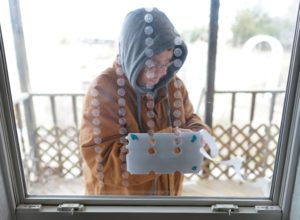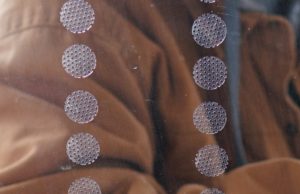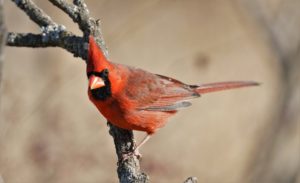Stopping the Awful SMACK! of Bird Collisions
Views: 477

It’s a sound I dread, the awful SMACK! as a bird crashes into one of our windows. All too often, we run outside to find the victim stunned or dead from the hit. Even birds that fly away are not necessarily okay; they may suffer from brain damage or hemorrhaging and die sometime later. In a disoriented state, the bird may be unable to forage for food or escape from predators. Many, many things can go wrong for a fragile, injured bird. (The end of this article provides care instructions for birds that have hit a window.)
In the U.S., it’s estimated that up to a billion birds die every year from window hits. To repeat that: up to a BILLION birds, most certainly millions. It’s a huge, underreported problem. So, if you’ve had it happen to you, you certainly aren’t alone.
Thankfully, there are ways to prevent it from happening again.
Why Bird Collisions Happen
There are many reasons why birds may hit a window. We had a hawk that would routinely dive through our yard to scatter panicking birds into our picture windows. The hawk would then circle back and pick up the dead or stunned birds for an easy meal. But clever predators are a tiny part of the problem.
Bird hits occur both night and day. Most frequently, they hit windows, but they strike other structures, too. Some species hit more frequently during migration season when they’re on the move, but many others hit residential windows year around.
Night Strikes
During migration, when millions of birds are moving to or from wintering and breeding grounds, they tend to fly at night. Before humans started building sky scrapers, power lines, and cell phone towers, there weren’t any hazards above the tree line for them to run into as they flew serenely above the landscape.
Now days, flying at night has become a deadly obstacle course for migrating birds. They hit buildings, towers, windmills, bridges… literally anything that sticks up into the sky. In many cases, birds are drawn to lighted windows which they subsequently crash into, or they get tangled with other birds that were also lured to the light. Walk around a tall building during migration season and there is an unfortunate chance you will find a dead bird or two.
Day Strikes
During the day, glass has a tendency to reflect like a mirror. So, windows will reflect the sky or trees or whatever happens to be around the building or your house. Birds see the reflected image, tricking them into thinking they are flying into open space. It’s also possible that birds may see appealing spaces inside a building or a path to the other side via another window.
In any case, they WON’T see the glass. SMACK!
Collectively, more bird collisions happen at residential properties than any other type of location. Sadly, our backyard birds are at greater risk from window collisions than migratory birds from tall buildings. If you think about it, it makes sense: we often encourage birds to congregate near our houses by feeding them and providing water.
Methods of Prevention
Thankfully, there is growing awareness of the problem, with far more solutions available today than there were even a few short years ago. Examples include cities encouraging building owners to turn off their lights at night and architects incorporating bird-safe glass into new construction.
Residential homeowners can make a big difference, too. I won’t detail all the possible solutions here, because this website does it better than I possibly could. It also provides a comprehensive list of bird collision prevention solutions. Largely, these solutions fall into these categories:
- Use stickers or dot patterns applied to the glass in tightly-spaced patterns, no more than two inches apart, enabling birds to see that there is a physical barrier present.
- Use a solid film applied to glass to make it less reflective or highly visible to bird eyes.
- Provide a physical barrier to keep the birds from hitting the window or deterring them from trying to fly through, and/or softening the blow if they do. These options include adding window screens or using visible lines, such as parachute cord, dropped in front of the window.

Unobtrusive stick-on dots designed to prevent bird collisions.
You can craft some of these devices yourself; others can be purchased.
If you feed birds, some simple steps may minimize bird collisions. You can move feeding stations to a distant location away from windows. Or, if your yard is small, you can move feeders closer to the window, so that birds will not gain enough momentum to hit with deadly force if startled from the feeder. Birds also distrust noisy, shiny, moving objects, so hanging things that twist, spin, and flash in the wind in front of windows may help reduce hits, although this will not prevent collisions altogether.
All these measure will help protect birds. It may seem like a lot of effort to save a bird or two, given the enormous scope of the problem, but the cardinal or songbird whose life you save may be the same bird that brightens your day whenever you see or hear it.

I’d hate for this handsome fellow to die by window strike. Prevention is worth it.
Meet Leslie Miller
Leslie Ann Miller shares 3.5 acres in rural Oklahoma with birds, butterflies and wide variety of animals. She is currently transforming her yard with plantings…
Leslie's Recent Posts

Nandina Berries Are Potentially Harmful to Birds: A Warning






